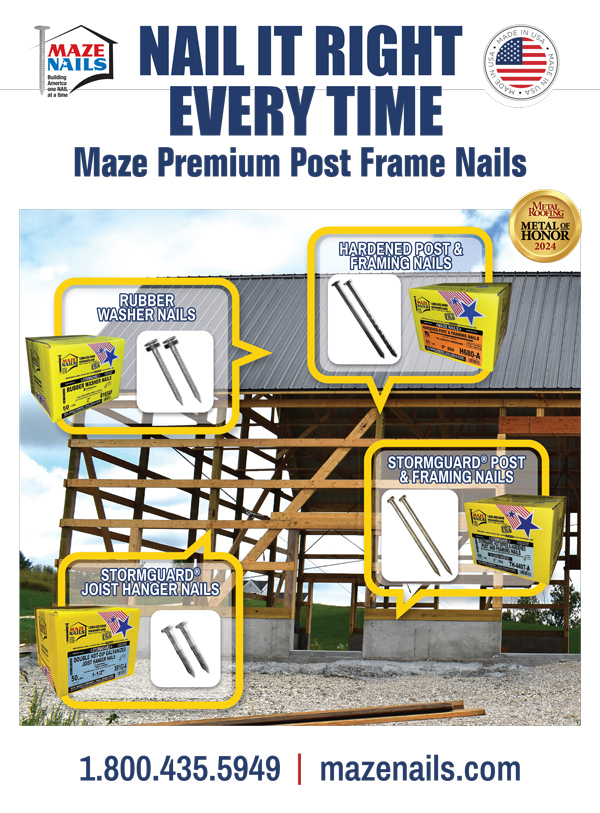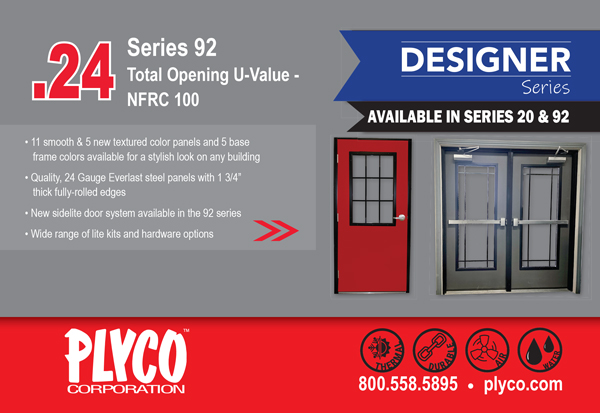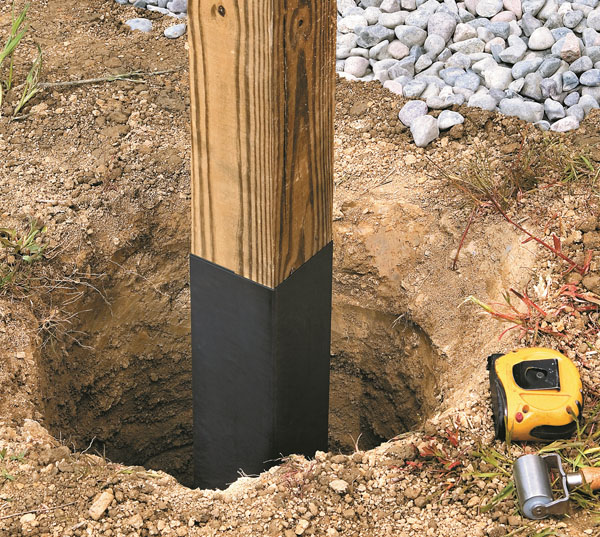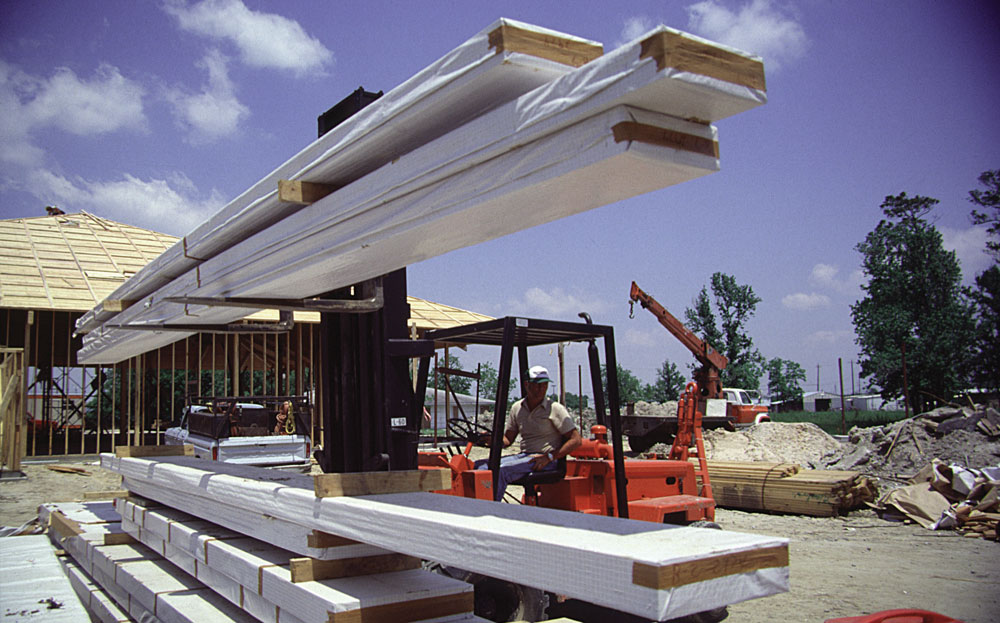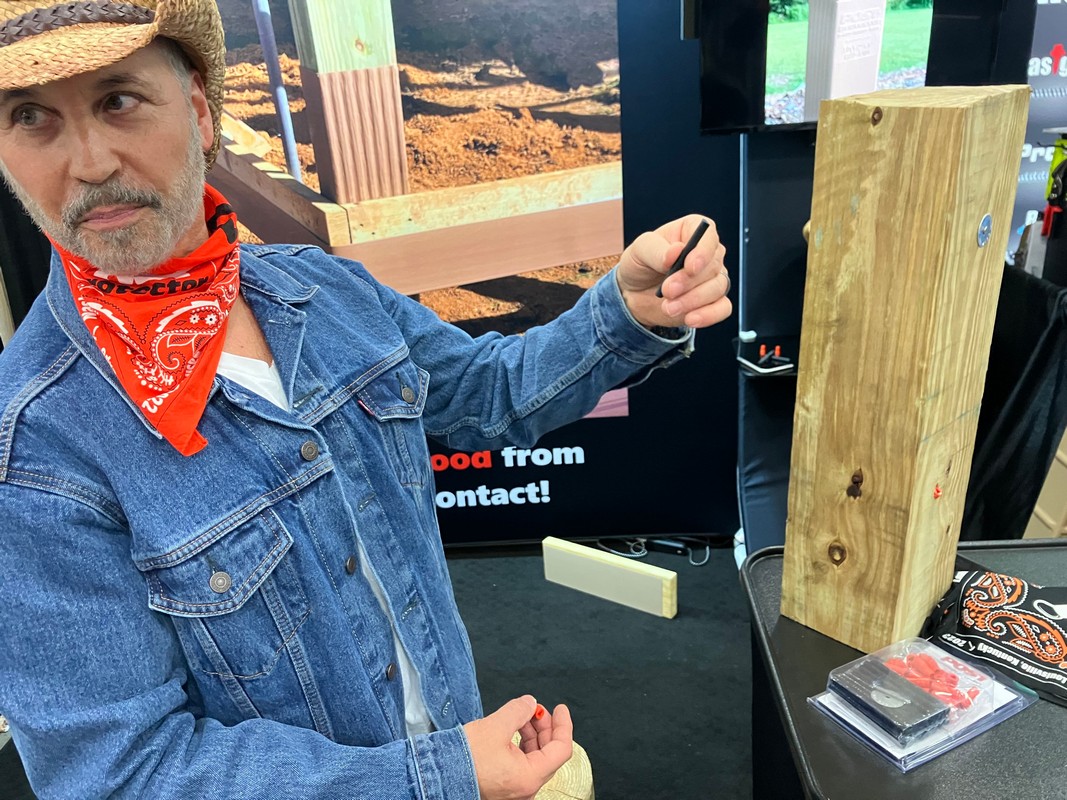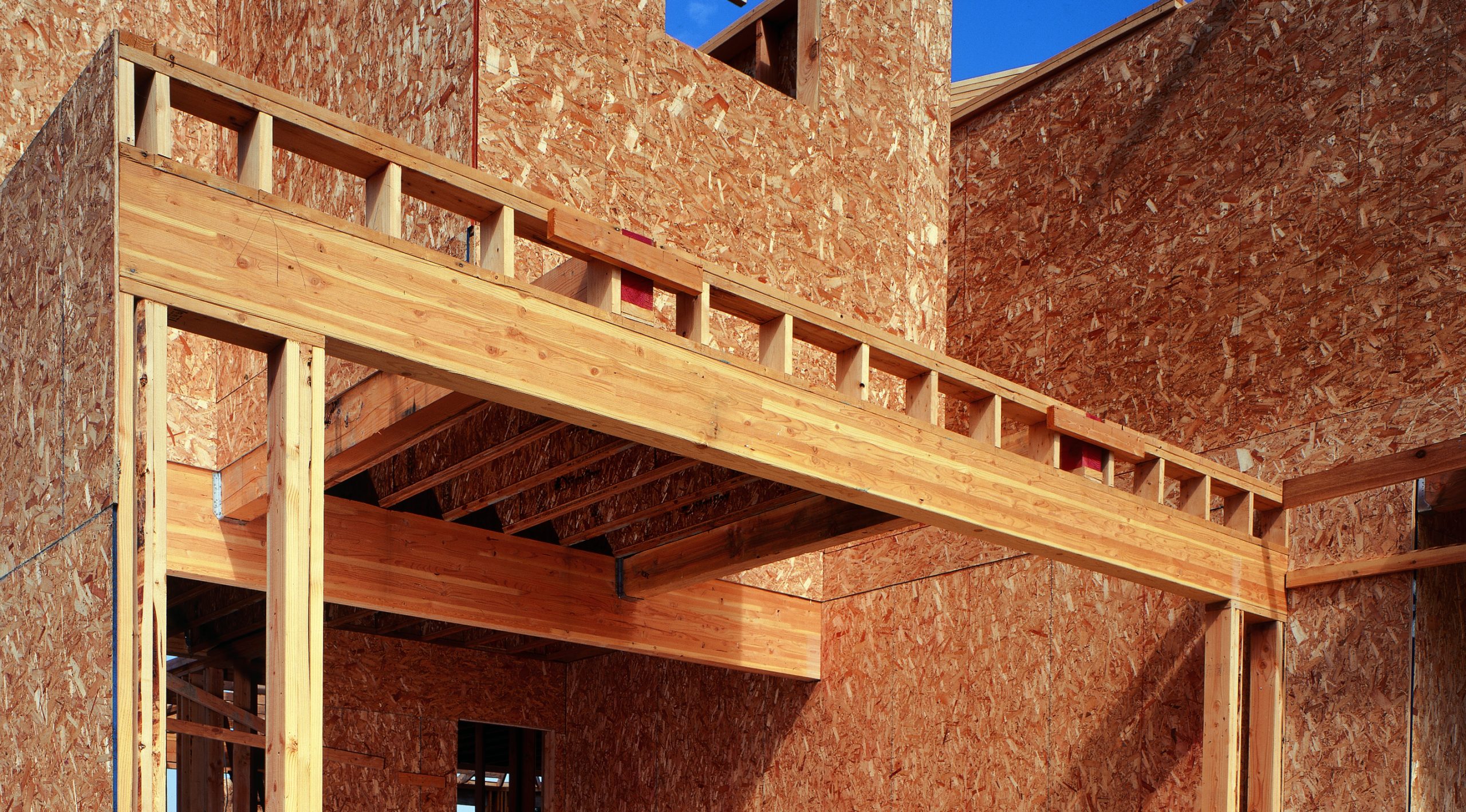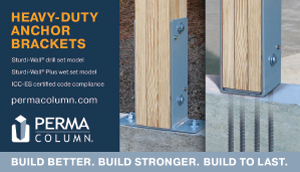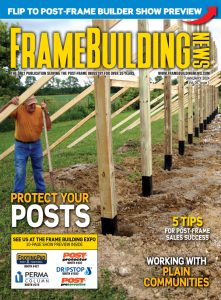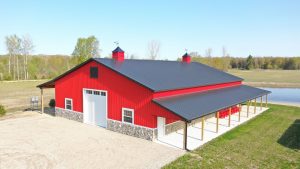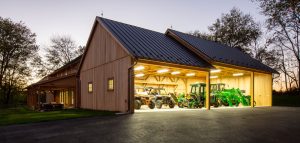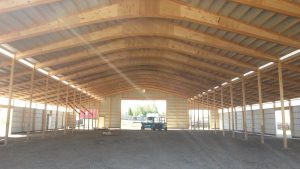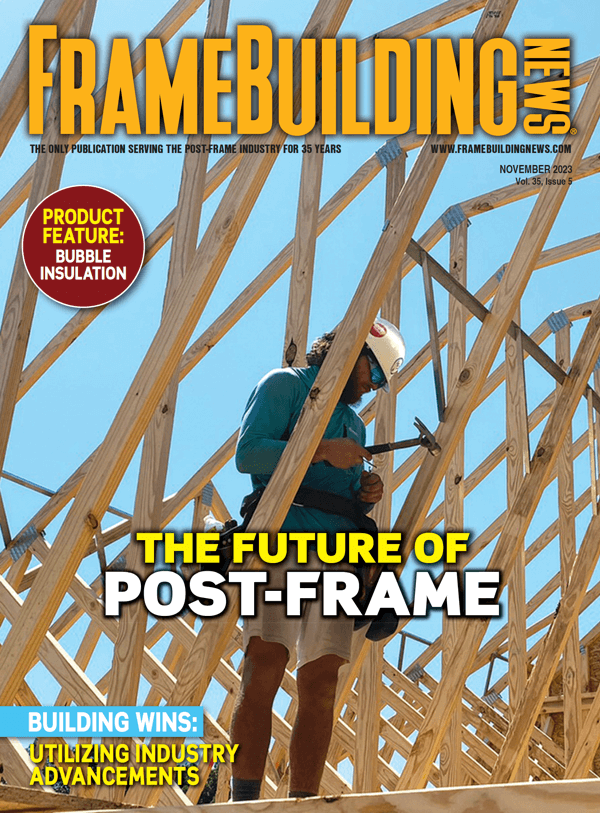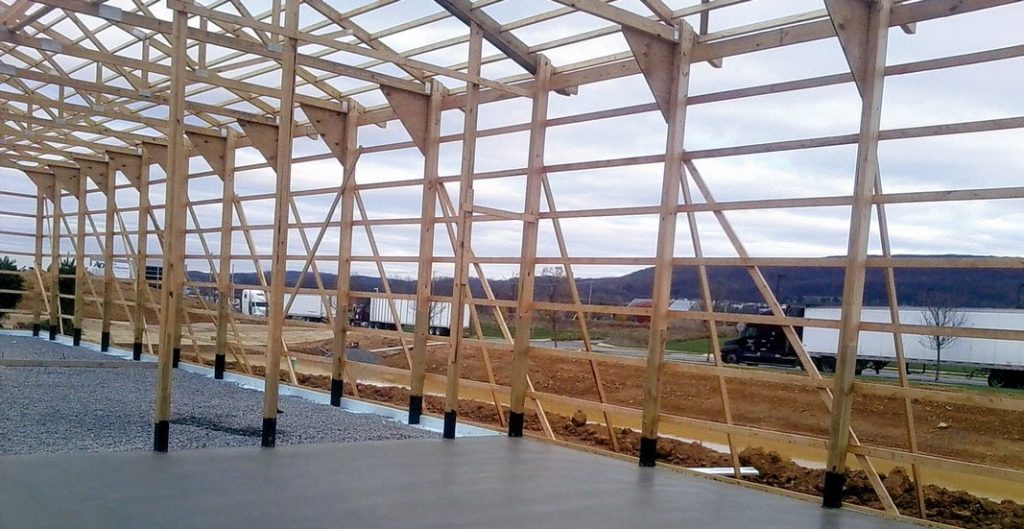
By Mark Robins
Post-frame builders know they shouldn’t put a wood support column into the ground untreated or uncovered. Wood rots when it gets wet. Unfortunately, modern technology has not solved that problem. While you might assume we’d be getting better at creating long-lasting poles using modern techniques, in reality, poles coming out of the factories today are very often lower quality than what was being produced 10 years ago. Here’s what you need to know and what to do about it.
Untreated Wood Posts
Why not put untreated or uncovered wood posts into the ground? “The challenge with non-treated posts in the ground is finding naturally durable species,” said Barry Hoffman, president at Planet Saver Industries / GreenPost. “In most areas of North America, we have seen non-treated posts in-ground lasting eight years and less.”
No matter how dry the ground may appear to be, it is rarely 100% dry. Even the driest earth will eventually accumulate moisture and this moisture will transfer to wooden posts. Biological decomposition causes post rot and that can destroy a structure. It is a silent destroyer, working below ground slowly destroying posts. You may not know you have post rot until it is too late.
Untreated and uncovered wood posts set directly into surrounding soil are likely to begin rotting as soon as their base absorbs some water. Even treated posts have their limits. “No matter what chemical protection is used, it doesn’t last forever,” said Ken McDonnell, president, Post Protector Inc. He said that even if that pressure-treated pole has chemical protection, “every year that passes, the chemical protection is depleting.” And nature takes over from there. “That’s why fungi are on the face of the Earth; the Good Lord put them here to recycle the nutrients and dead plants,” he said.
Proper Pressure & Chemical Treatment
Wood columns that are destined for the ground get both chemically treated and pressure treated, but not all treated lumber is created equally. There are different types of treatments for different applications.
Are there certain wood posts certifications to watch for? The AWPA Use Category system provides a simple way to select preserved wood products by relating to the end use of wood product directly to the appropriate AWPA Standard. Use Categories define a series of different exposures for preserved wood products that may be used in construction. The AWPA Use Category for vertical posts for frame building is: UC4B: Ground Contact, Heavy Duty Wood used in contact with the ground either in severe environments, such as horticultural sites, in climates with a high potential for deterioration or in critically important components. Hoffman said most regions will dictate what type of treatment is allowed and required to be used depending on what the post is being used for.
“When we talk about structural posts in the ground, they require a higher level of treatment than your standard miscellaneous piece of lumber that’s above ground,” said Adam Kraus, structural engineer at Wick Buildings. “There are differences in treatment levels and types for different applications. Wick follows all American Wood Protection Association (AWPA) procedures for the appropriate type and dosage of treatments for our posts for in-ground.”
Wooden posts come from the factory pressure-treated with a copper preservative called ACQ, a type of water-based wood preservative product that is applied at timber treatment plants by industrial vacuum-pressure impregnation. As a copper carrier, ammonia can penetrate difficult-to-treat wood better than other waterborne preservatives.
All of the experts interviewed said that treatment is inconsistent, though. “I’ve seen posts that haven’t stood the test of time,” said Dave Gruhlke, president of Plasti-Sleeve, Zimmerman, Minnesota. “There are always inconsistencies in treatment.”
“When a treated post has maximum chemical protection only then does it get the tag on the bottom saying suitable for ground contact,” McDonnell said. “Because ground contact decay hazards are severe, that’s why you need maximum chemical absorption and retention for ground contact. If you have 24 posts on your jobsite, no two of them have the exact same decay-resistance index. There are multiple variables such as wood density and how it accepts the penetrating process — the process that forces the pesticide into the wood. No two pieces of wood are going to have identical absorption and retention characteristics.”
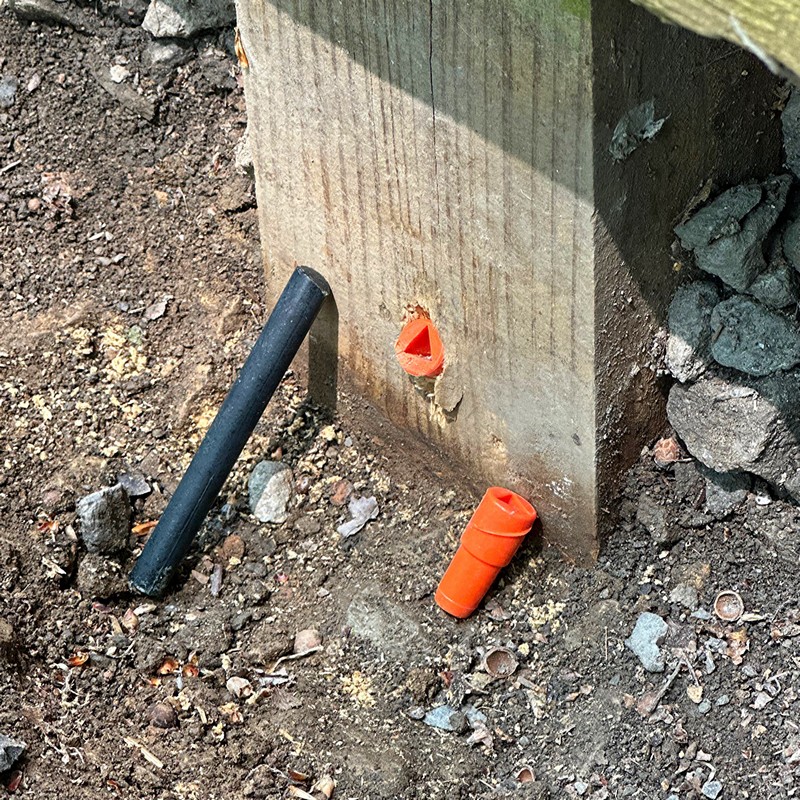
Inconsistency in Post Production
How can you ensure your wood posts are good for in-ground use? This is a very important question because Mark Stover, president at Perma-Column, said the lumber industry today is producing hybrid trees and they’re not the same as what people now call “old-growth trees.”
“Wood quality and strength overall have been declining because of hybrids,” Stover said. “Hybrids are designed to grow faster, and with them growing faster they tend to be less dense. With them being less dense than wood in previous decades, it opens them up to more disease and infection. When it comes to bacteria, when it is mixed with air and water, it creates rot. There’s a greater incidence of rot these days. The quality of wood isn’t as strong as it was previously because the forests are designed as hybrid and they are designed to grow quicker. You don’t have the density of the wood so much.”
Hoffman said, “With the introduction of faster-growing timbers there is a tremendous variation in wood density and over the last 24 to 36 months. We are seeing what appears to be a major challenge in achieving uniform treatment. On a common timber used for post-frame construction we historically had 80 to 90 growth rings. With the introduction of faster growing timbers, we now see 24 to 28 growth rings consistently. The indications are since the growth rings are much farther apart, the posts are taking in more moisture during ground wetting and drying cycles. We now have builders reporting that they are seeing rot occur in 8 to 9 years even when treated.”
Identifying a Bad Post
How can builders tell a good post from a bad post? That’s not easy, even to a trained eye. Here’s the advice of our experts.
Stover: “Who are you buying them from? It’s tough to determine if a post is properly treated. Treatments are stamped. There is a certification process that comes out of these treaters on the quality of the wood. I would check on that certification and who you buy from and go with that. There is documentation behind that stamp and you have to be comfortable with your supplier.”
Kraus said that this stamp “is not always visible depending on where the lumber was cut, where it’s placed or how it’s facing. [This] treatment stamp regards the type of treatment and dosage.”
McDonnell: To ensure good treatment, examine your posts. Look for problems and splits with the wood that can, “expose internal non-treated material and the micro-organisms can pounce on that. That’s when you get core decay. Micro-organisms are feeding on the filet mignon — the center of the post that never got chemical protection.”
Hoffman said treatments that show a different color than the wood itself, or absence of color, are good indications of inconsistent treatment.
Krause agreed to watch for post discoloration in relation to the rest of the post. “The bulk of the post is one color. You would most likely see this discoloration at the base of the groundline. This is an indication of section loss. Also, if you poke something into the post and its shaft is easily penetrated, that’s an indication that something is not quite right.”
Gruhlke: “Visually — would be my only recommendation; if the post doesn’t look good, if it is twisted or if it is cracked. They used to say check the color of the wood but I don’t know if that is in effect anymore because of the variety of treatment methods they use on the wood.”

Receiving a Poorly Treated Post
What should a builder or contractor do if they think they think they’ve received a poorly treated post? Ask for a replacement? Gruhlke said, “If I bought a post with twists or cracks in it, I would contact my supplier.”
Kraus agreed that when dealing with a problem post, reach out to your supplier. “Say, ‘Here’s what I know about treated posts. Can you tell me what your product is? And, what should I expect out of this product? Why don’t I have this level of treatment on my posts?’”
Should a builder try re-treating a post themselves? No. “Customers shouldn’t just replace a post without knowing what they are doing,” Kraus said.
Hoffman said because of regulations in most areas self-treating is usually not an option. “When you get a bad post, you can’t retreat it yourself,” Stover added. “You can’t get certification if you do that. And, most of the chemicals in these treatments are not safe for the standard homeowner or builder to deal with. You don’t know that the treatment is bad until years down the road.”
Options After Initial Treatment
There are solutions to this challenge, of course, which is why the post-frame industry is creating long-lasting buildings.
Scott Roesner, national sales and marketing director, Structures Wood Care Inc. said, “[When] vertical posts are sunk into the ground, they should have gravel or concrete surrounding them. If any water should get into the ground, it will not have direct contact with the wood. This also keeps the post from moving during weather changes. If you set them in concrete, make sure the top is sloped away from the wood. Gravel will move that water away from the wood.”
As most builders know, Perma-Column is a solution that prevents the wood from going into the ground in the first place. “We sell concrete posts the (Perma-Column Precast Concrete Post, ICC-ESR certified) that you would take an untreated post and attach it to the top bracket of,” Stover said. “What we put in the ground doesn’t need to be treated because it is concrete. When wood is out of the ground, above grade, inside a building like a pole barn, it doesn’t need to be treated. You can take an untreated wood post and attach it to a Perma-Column and put that in the ground. That will keep wood out of the ground and you will have no issue with rot.”
If you’re going to stick with the more traditional wood post, how can you guard against premature post decay? Some products like Post ProServative treat the wood, while others like Planet Saver’s GreenPost and Plasti-Sleeve cover it.
“Our Post ProServative product is a time-release preservative system that re-treats an in-service wooden post from the inside out,” McDonnell said. “It delivers a tough ‘barrier system’ which eliminates soil-to-wood and concrete-to-wood contact. Used in utility poles for over 25 years with great success, it is now available to the general public to help protect or re-treat post and pole infrastructure.”
McDonnell also has a product that literally covers the post. Post Protector is a sleeve that “separates the post from ground contact and the micro-organisms that dwell within. The micro-organisms can never get to the wood. It is made out of landfill-liner material with a 450-year shield application half-life.”
Gruhlke said his company’s Plasti-Sleeve product is the original post-protection sleeve, originating in 1994. “It’s an accessory with enhanced protection against rot. It’s a molded, high-density, one-piece, Polyethylene plastic cover sleeve that encapsulates the lower portion of the post and isolates it from organic ground contact and other things that are in contact with the wood. Our product enhances and provides a barrier to treated wood. It’s a slide-on application. You can use a nail or screw to attach it on the top. The plastic will last indefinitely.”
Planet Saver Industries’ Green Post product is another coverage option, in this case with a coating and a wrap that Hoffman said “provides a double-barrier protection keeping rot and decay elements from getting to the post as well as keeping treatments in the post where they belong. It wraps and protects in-ground wood applications from the elements. The double-layer wrap is a factory-applied heat seal to the lumber, delivered ready to install with an uplift-restraint system. Green Post’s solution is non-toxic, environmentally friendly, and termite tested.” FBN
Wood Facts
Common Wood Choices
Most builders will simply choose the posts that are offered to them by the supplier, and that is typically Southern Yellow Pine. Here are some options.
- Southern Yellow Pine: Readily available and cost-effective, making it an attractive option for many builders. It must be treated if it’s going to be used in the ground.
- Douglas Fir: Known for its strength and natural resistance to decay and insects. It should be treated even though it has natural resistance. More expensive and durable than pine but typically not a necessary upgrade.
- Cedar: Naturally durable, beautiful, and resistant to decay. Not typically used because the posts are usually covered in post-frame so its beauty goes to waste. Some people would say they don’t need to be treated if they’re going in the ground, but that is not a popular opinion – posts going into the ground should be treated.
Wood Treatment Methods
All posts that are going into the ground should either be treated or covered, preferably both. To guard against decay and insects, here are the two primary methods for treating wood.
- Pressure Treatment: In this process, the wood is loaded into a treatment cylinder, and preservatives are forced deep into the wood under high pressure. The pressure treatment process ensures even distribution of preservatives throughout the wood, making it highly resistant to decay and insects. It is the preferred treatment method for posts used in outdoor applications. The most-common preservative used in pressure-treated wood today is alkaline copper quaternary (ACQ).
- Dip Treatment: Involves immersing the wood in a preservative solution, allowing the wood to absorb the treatment. It is often used for smaller, less critical applications or when pressure treatment is not available or practical.
Column Protection Suppliers
Perma-Column LLC
Ossian, Indiana
(260) 622-7190
www.permacolumn.com
PermaSeal USA
Chesterfield, Missouri
(844) 481-6862
www.permasealusa.com
Planet Saver Industries/GreenPost
East Earl, Pennsylvania
(610) 377-3270
www.planetsaverind.com
Plasti-Sleeve
Zimmerman, Minnesota
(877) 775-3383
www.plastisleeve.com
Post Protector Inc.
Pottsville, Pennsylvania
(877) 966-8768
www.postprotector.com
To read more articles from the January 2024 edition click here.
To read more articles about post-frame post protection click here.


